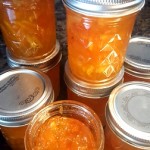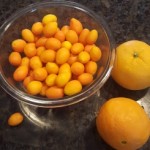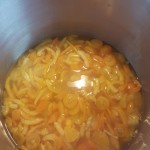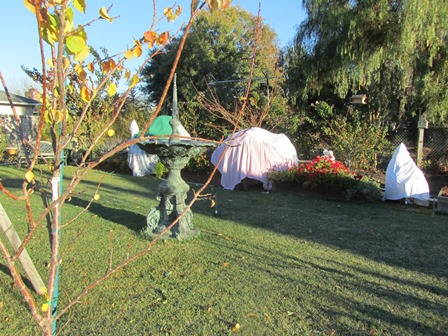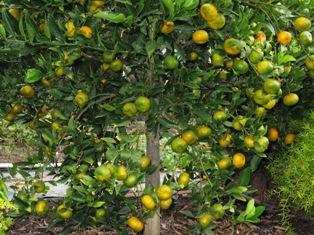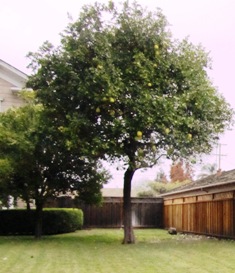How to Make Kumquat Marmalade
Eating a fresh kumquat–the small relative to the sweet orange–is like getting a dose of Vitamin C in a single bite. Or, if you don’t like the tart fruit (the edible rind is sweet), then make your kumquats into a marmalade.
My neighbor recently brought over several boxes of freshly-picked kumquats. We ate some fresh but I turned the rest into a sweet, spread that tastes quite like orange marmalade.
When fruit is available during the year, you can turn that fruit into a delicious conserve, jelly jam, marmalade, or fruit butter. When citrus is in season, oranges, kumquats, grapefruits, and lemons can be coverted to sweet spreads.
There are distinct differences between conserve, jam, jelly, marmalade, and fruit butter. Conserve is a jam made from fruit with other ingredients added, including raisins, coconut, and nuts. Jelly is made from the juice of the fruit while jam is made from the fruit pulp. Marmalade includes fruit, juice, and rind. A fruit butter utilizes the fruit pulp and sugar to make a thick, smooth spread.
KUMQUAT MARMALADE RECIPE
Ingredients:
2 cups thinly sliced kumquats
1.5 cups chopped orange pulp (2 medium oranges)
1.5 cups sliced orange peel (2 medium oranges)
1/3 cup lemon juice
1.5 quarts water
Sugar (the amount will depend on the amount of fruit/water mixture after 12 hours)
Directions:
Mix together all ingredients, except the sugar, in a deep large pot. Simmer for 5 minutes. Remove from heat and cover. In a cool place, allow the mixture to stand for 12 hours or overnight to soften the rind. Remove any large seeds. Cook rapidly until peel has softened. Measure out fruit and liquid mixture and then add 1 cup of sugar for each cup of the fruit mixture. Stir until the sugar is dissolved.
Rapidly bring the mixture to a boil over high heat. Stir as needed to prevent sticking, especially as the mixture thickens and reaches the gelling point. (Hint: You can check to see if the marmalade is gelling by dropping a spoonful of the hot marmalade onto a chilled or frozen saucer. If the marmalade is sheeting instead of running off the plate, it’s ready to can. Also, you can add Classic Pectin according to directions on container to ensure the marmalade properly thickens). Stir in carefully to avoid splattering on your skin. Remove from heat. If the mixture has foam, skim to remove it. And also remove any large seeds that may have been missed.
Ladle the hot fruit mixture into hot jars (run the jars through a hot rinse cycle as the jam is cooking). Leave 1/4-inch headspace. Tighten the ring around the flat, rubber-seal cap. Place the jars into a boiling-water canner. Bring to a boil and process 10 minutes. Remove jars from canner and let stand until cool. The caps will make a popping sound as they cool and seal.
__________________________________________________________________

- All of Meera Lester’s Henny Penny Farmette mysteries are available online and in bookstores everywhere. Also, check out Meera Lester’s self-help books on health, wellness, and spirituality on Amazon.com See: https://www.amazon.com/Meera-Lester/e/B001JP835E
Warm Pomegranate Sauce Dressing Dazzles on Spinach Salad
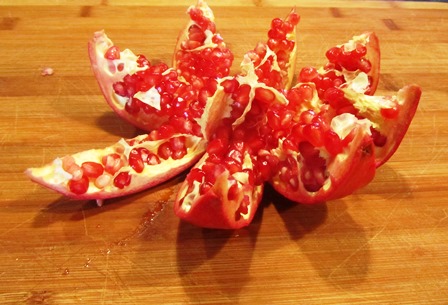
Pomegranate seeds add sweetness and crunch to salads but can eaten fresh, or you can extract the juice to make a lovely sauce.
Use fresh pomegranate juice if you would like a delicious sauce to use in salad dressing or other culinary creations. Pomegranate sauce made into a warm salad dressing dresses up a plain spinach salad like nothing else.
The warm pomegranate dressing is made by combining to blend 1/2 cup pomegranate sauce (recipe below), 1 Tablespoon of honey, 1 1/2 teaspoons minced fresh ginger, 1 cup California extra-virgin olive oil, and 1/2 cup coarsely chopped walnuts. Warm the dressing and pour over over a pound of freshly washed spinach leaves, 1/2 cup red onion, and 1 orange (peeled, seeded and with segments quartered).
Here’s how to make and preserve the pomegranate sauce.
INGREDIENTS:
5 cups of pomegranate juice (reamed from about 10 large fruits)
1/2 cup lemon juice
1 cup sugar
DIRECTIONS:
Wash thoroughly ten large pomegranates.
Cut in half and use a reamer to extract the juice from the seeds, discarding the membrane.
Strain the juice through cheesecloth several times to obtain 5 cups.
Combine the juice, lemon, and sugar in a large saucepan over medium-high heat.
Bring to a boil and then turn down the heat and simmer at 180 degrees Fahrenheit.
Reduce the sauce by half.
PROCESS:
Have ready 4 half-pint jam jars that have been washed on a hot cycle in the dishwasher and dried.
Fill the canner with water, place on heat, and bring to a simmer.
Simmer jar lids and rings.
Fill the jars with the pomegranate sauce, leaving 1/4 inch head space.
Affix hot lids to the jars and screw on the rings.
Lower the jars on the rack into the canner (water must cover the jars by at least an inch) and boil the water for 10 minutes.
Remove the jars of sauce and allow to cool.
Check seals, label, and then store until needed.
For more delicious recipes, farming tips, and beekeeping strategies as well as a cozy mystery, check out the first book in the Henny Penny Farmette series from Kensington Books in New York. Available on Amazon.com, Barnesandnoble.com, and in other online and traditional bookstores everywhere.

Blankets for Trees & Bees on Frosty Nights
I don’t like to take chances with my citrus trees when overnight temperatures drop to near freezing. I cover them with sheets and blankets.
My hives are in a wooden shelter with a tin roof and the back side open, so I can work without any encumbrance. But I don’t want the bees to have to work harder to keep the hive warm for the queen and babies, so I throw some blankets over my beehives, too.
Also, on particularly cold nights, I hang a warming lamp in my chicken house. My rule of thumb for my hens is when overnight temperatures are expected to drop below 45 degrees, I turn on the lamp so the hens aren’t stressed.
An advantage of hanging a heat lamp in the chicken house is to foster egg laying at time when shorter days of light slows egg production. The heat lamp makes light available to the chickens for a much longer period.
Pruning Sixty-Year-Old Citrus Trees
When a friend who owns a house in San Jose asked for help in pruning her citrus trees (a lime, satsuma mandarin, and a grapefruit) during the first weekend in December, we agreed. The house had a lovely stone courtyard with two large citrus trees that had remained prolific producers in spite of being neglected for the last 20 years. The trees had been planted, she told us, approximately 60 years ago by an aunt.
Standard size citrus trees can reach 20 to 30 feet and spread almost as wide. Dwarf citrus, however, only reaches four to ten feet. The latter can be grown as landscape specimens or in pots where they can be easily moved around to protect them from frost and wind. In really hot, dry conditions, citrus in pots may need daily watering.
Once in San Jose, we checked the trees for diseases and pests. Aside from some of the lime leaves that had turned yellow, suggestive of too either much water or iron chlorosis (simply corrected with a little iron sulfate or chelated iron), the trees otherwise looked pest-free and loaded with ripe fruit.
Wearing gloves and long sleeves to protect against thorns, we shook the trees vigorously to remove unpicked fruit of previous seasons and the current season’s ripe fruit. The shaking yielded a five-gallon bucket and two partially full contractor bags of delectable limes and satsuma mandarins. The owner was delighted to have so much fruit. She even offered us some to make into marmalade, but we explained we had plenty of our own citrus on the farmette.
We carefully pruned out all the old dead branches and began shaping the trees, lifting and cutting branches that pointed down, removing crossed-over limbs, and cutting away branches that compromised the courtyard fence. Our work reduced the height and width of the trees (making it easier to harvest any fruit still hanging).
The work went smoothly. We even had time to tackle the ragged-looking grapefruit tree in the back. By the end of the day, we had freed three beautiful trees from a tangle of dead limbs and picked many pounds of fruit. The trees were once again serving the purpose for which they were planted–heavy producers that enhanced the beauty of the landscape.
 Facebook
Facebook Goodreads
Goodreads LinkedIn
LinkedIn Meera Lester
Meera Lester Twitter
Twitter



